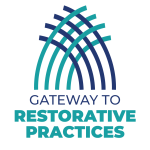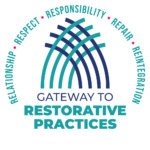My last blog post, Why Didn’t I Include Restorative Circles in Every Workshop? left me feeling disappointed in myself for not realizing the criticalness of this years ago.
For the three workshops on my schedule, I revised the workshops and added a circle component. I’m going to briefly explain the changes I made in each workshop and the impact on the participants and me as a trainer.
The First Workshop
The first workshop was the Power of Affective Statements. Although the workshop included partner activities, small group discussion, and self-reflection, it didn’t have a circles component.
After I got the small group into a standing circle, I introduced the concept.
“Today we’re going to do what’s called a check-in circle. Since we’re dealing with the topic of emotions today, I’m going to ask each of you to answer this prompt. What color describes how you feel today?”
With a reminder that they can pass the talking piece to the next person without answering the prompt, one-by-one participants state their color feeling. On my turn I share, “Mine is orange.” Various colors are mentioned nonchalantly until one participant says, “Black.” A collective hush comes over the group. The next participant holds onto the talking piece unsure if she should add her color or not. After a brief pause, the circle continues until everyone has shared.

As the circle keeper, I’m concerned about such a dark answer. I wonder, what happened today? What’s going on? What’s behind the answer? How can I support this person?
Quietly talking with my colleague later, I gain insight into a few brief details and offer some encouragement. I wonder, what if I hadn’t used a check-in circle today? I would have been the one in the dark.
Second Workshop
Restorative Apologies: Beyond Just Sayin’ Sorry is the next workshop. This time I created several community building circle prompts instead of using the existing discussion questions. The first four prompts go well until the last one. “Forgiveness means …” A few participants articulate an answer, but the majority simply say, “Pass,” in a hushed voice.
Based on their responses, I decided I’d include some personal examples of forgiveness to potentially open the discussion. This fosters some personal responses around the struggles with forgiving ourselves and others. Several participants honestly share about their struggles with forgiveness.
Third Workshop
More Affective Guidance Techniques with mostly the same participants as the two previous workshops. I notice that two participants drag themselves into the classroom. Before the workshop officially begins, I speak with them individually.
After the past two workshops the group knows the routine. Today’s prompts seem fairly “safe,” so I’m not too concerned about the responses. I say,
“Today we’re doing what is called Fist-to-Five. Using your hand, you will show how your day has gone. For example, a five might be an excellent day where a fist might be a horrible day.”
I hold up three fingers and say, “I’m a three today,” The young man next to me proudly proclaims, “I gotta say, I’m a five.” But as answers are shared, the numbers are low. I notice one zero, two ones, and two twos. There’s more going on here than meets the eye. When the talking piece returns to me I say, “It sounds like some of us are struggling today. Let’s take a few deep breaths together before we continue.”
The workshop is officially over but the participants want to continue the “discussion.” After stating that they are free to leave, but I’m willing to stay if they want to continue, they stay another seven or eight minutes. I listen to their concerns and assure them I’ll share them with their administrator.
Nothing was resolved that day, but participants had a chance to voice their frustrations and problem-solve ideas while I was able to listen to their concerns and facilitate further discussion.
New Resolve
After every training session, I reflect on how it went. How were participants engaged? What parts didn’t they understand? What changes can I make to improve the workshop? What should I delete? The good news is that with four trainers presenting workshops over multiple years, improvements are made regularly, often based on observations and interactions with participants.
After adding circle prompts to these three workshops, I feel hopeful. I witnessed the impact the circle prompts had on the participants and me. As a trainer, I typically begin training after welcoming and chit-chatting with early arriving participants. But that didn’t give me insight into their lives like using circles prompts did. When using the circles, I felt empowered to actively engage in participants’ lives beyond simply the content.
Agenda Item
After that three workshops that I specifically added a circle component to were completed, I asked for an agenda item at our regular Restorative Practices collaboration meeting. Agenda Item: Adding check-in circle prompts to workshops and why.
Why? Because there’s power in circles to connect with others and build relationships. The trainers can not only talk about life-changing circles but practice them with others. Relationships truly build the foundation for restorative practices.
Image source: All of these Emotions of Mine – Chiaroscuro Self-Portrait [Flickr.com]

